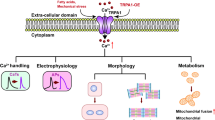Abstract
Generation of a large number of cells belonging to the cardiac pacemaker system would constitute an important step towards their utilization as a biological cardiac pacemaker system. The aim of the present study was to identify factors, which might induce transformation of a heterogenous population of fetal cardiomyocytes into cells with a pacemaker-like phenotype. Neuregulin-1 (α- and β-isoform) or the cAMP was added to fresh cell cultures of murine embryonic cardiomyocytes. Quantitative northern blot analysis and flowcytometry were performed to detect the expression of connexins 40, 43 and 45. Patch clamp recordings in the whole cell configuration were performed to determine current density of I f, a characteristic ion current of pacemaker cells. Fetal cardiomyocytes without supplement of neuregulin or cAMP served as control group. Neuregulin and cAMP significantly increased mRNA levels of connexin 40 (Cx-40), a marker of the early differentiating conduction system in mice. On the protein level, flowcytometry revealed no significant differences between treated and untreated groups with regard to the expression of connexins 40, 43 and 45. Treatment with cAMP (11.2 ± 2.24 pA/pF; P < 0.001) and neuregulin-1-β (6.23 ± 1.07 pA/pF; P < 0.001) significantly increased the pacemaker current density compared to control cardiomyocytes (1.76 ± 0.49 pA/pF). Our results indicate that neuregulin-1 and cAMP possess the capacity to cause significant transformation of a mixed population of fetal cardiomyocytes into cardiac pacemaker-like cells as shown by electrophysiology and increase of Cx-40 mRNA. This method may allow the development of a biological cardiac pacemaker system when applied to adult or embryonic stem cells.


Similar content being viewed by others
References
Alcolea S, Jarry-Guichard T, de Bakker J et al (2004) Replacement of connexin40 by connexin45 in the mouse: impact on cardiac electrical conduction. Circ Res 94:100–109
Brown HF (1982) Electrophysiology of the sinoatrial node. Physiol Rev 62:505–530
Cerbai E, Pino R, Porciatti F et al (1997) Characterization of the hyperpolarization-activated current, I f, in ventricular myocytes from human failing heart. Circulation 95:568–571
Coppen SR, Kaba RA, Halliday D et al (2003) Comparison of connexin expression patterns in the developing mouse heart and human foetal heart. Mol Cell Biochem 242:121–127
Delorme B, Dahl E, Jarry-Guichard T et al (1995) Developmental regulation of connexin 40 gene expression in mouse heart correlates with the differentiation of the conduction system. Dev Dyn 204:358–371
DiFrancesco D (1991) The contribution of the ‘pacemaker’ current (if) to generation of spontaneous activity in rabbit sino-atrial node myocytes. J Physiol 434:23–40
DiFrancesco D (1993) Pacemaker mechanisms in cardiac tissue. Annu Rev Physiol 55:455–472
DiFrancesco D, Tortora P (1991) Direct activation of cardiac pacemaker channels by intracellular cyclic AMP. Nature 351:145–147
Er F, Larbig R, Ludwig A et al (2003) Dominant-negative suppression of HCN channels markedly reduces the native pacemaker current I(f) and undermines spontaneous beating of neonatal cardiomyocytes. Circulation 107:485–489
Gassanov N, Er F, Zagidullin N et al (2004) Endothelin induces differentiation of ANP-EGFP expressing embryonic stem cells towards a pacemaker phenotype. FASEB J 18:1710–1712
Gochberg SH (1964) Congenital heart block. Am J Obstet Gynecol 88:238–241
Hoppe UC, Beuckelmann DJ (1998) Characterization of the hyperpolarization-activated inward current (I f) in isolated human atrial myocytes. Cardiovasc Res 38:788–801
Hoppe UC, Jansen E, Südkamp M et al (1998) A hyperpolarization-activated inward current (I f) in ventricular myocytes from normal and failing human hearts. Circulation 97:55–65
Klug MG, Soonpaa MH, Koh GY et al (1996) Genetically selected cardiomyocytes from differentiating embryonic stem cells form stable intracardiac grafts. J Clin Invest 98:216–224
Kusumoto FM, Goldschlager N (1996) Cardiac pacing. N Engl J Med 334:89–97
Meyer D, Birchmeier C (1995) Multiple essential functions of neuregulin in development. Nature 378:386–390
Miake J, Marban E, Nuss HB (2002) Biological pacemaker created by gene transfer. Nature 419:132–133
Michaelsson M, Engle MA (1972) Congenital complete heart block: an international study of the natural history. Cardiovasc Clin 4:85–101
Moorman AF, de Jong F, Denyn MM et al (1998) Development of the cardiac conduction system. Circ Res 82:629–644
Muller M, Fleischmann BK, Selbert S et al (2000) Selection of ventricular-like cardiomyocytes from ES cells in vitro. FASEB J 14:2540–2548
Potapova I, Plotnikov A, Lu Z et al (2004) Human mesenchymal stem cells as a gene delivery system to create cardiac pacemakers. Circ Res 94:952–959
Qu J, Plotnikov AN, Danilo P Jr et al (2003) Expression and function of a biological pacemaker in canine heart. Circulation 107:1106–1109
Rentschler S, Zander J, Meyers K et al (2002) Neuregulin-1 promotes formation of the murine cardiac conduction system. Proc Natl Acad Sci USA 99:10464–10469
Ruhparwar A, Haverich A (2003) Prospects for biological cardiac pacemaker systems. Pacing Clin Electrophysiol 26:2069–2071
Ruhparwar A, Tebbenjohanns J, Niehaus M et al (2002) Transplanted fetal cardiomyocytes as cardiac pacemaker. Eur J Cardiothorac Surg 21:853–857
Schulze-Bahr E, Neu A, Friederich P et al (2003) Pacemaker channel dysfunction in a patient with sinus node disease. J Clin Invest 111:1537–1545
Soonpaa MH, Koh GY, Klug MG et al (1994) Formation of nascent intercalated disks between grafted fetal cardiomyocytes and host myocardium. Science 264:98–101
Wainger BJ, DeGennaro M, Santoro B et al (2001) Molecular mechanism of cAMP modulation of HCN pacemaker channels. Nature 411:805–810
Acknowledgments
This study was supported by the Deutsche Forschungsgemeinschaft (Ho 2146/3-1)
Author information
Authors and Affiliations
Corresponding author
Rights and permissions
About this article
Cite this article
Ruhparwar, A., Er, F., Martin, U. et al. Enrichment of cardiac pacemaker-like cells: neuregulin-1 and cyclic AMP increase I f-current density and connexin 40 mRNA levels in fetal cardiomyocytes. Med Bio Eng Comput 45, 221–227 (2007). https://doi.org/10.1007/s11517-007-0164-3
Received:
Accepted:
Published:
Issue Date:
DOI: https://doi.org/10.1007/s11517-007-0164-3




